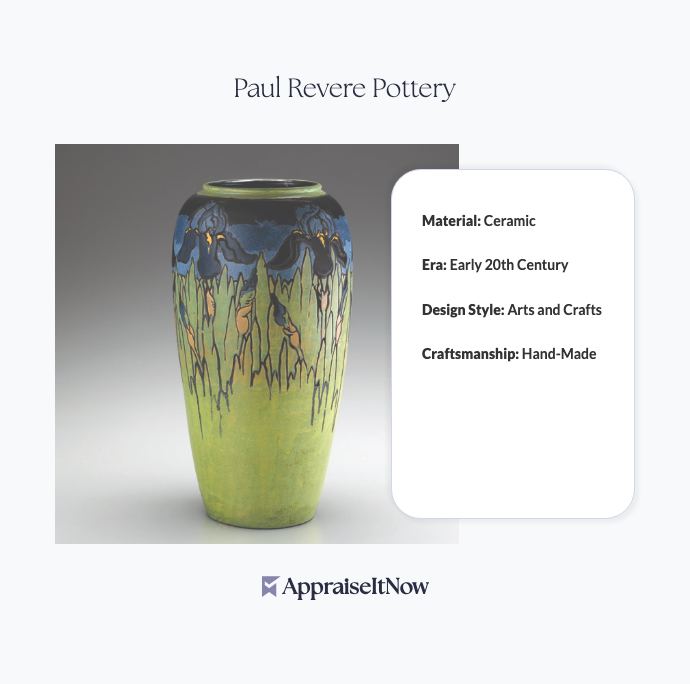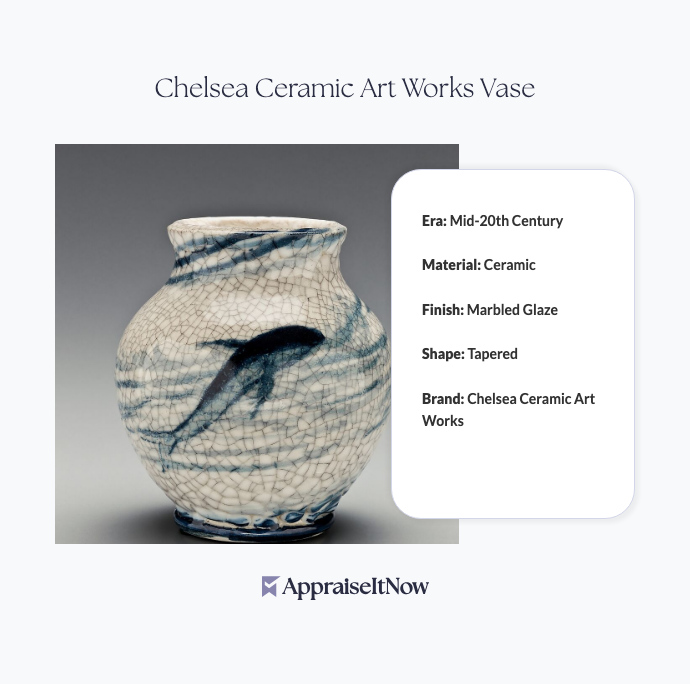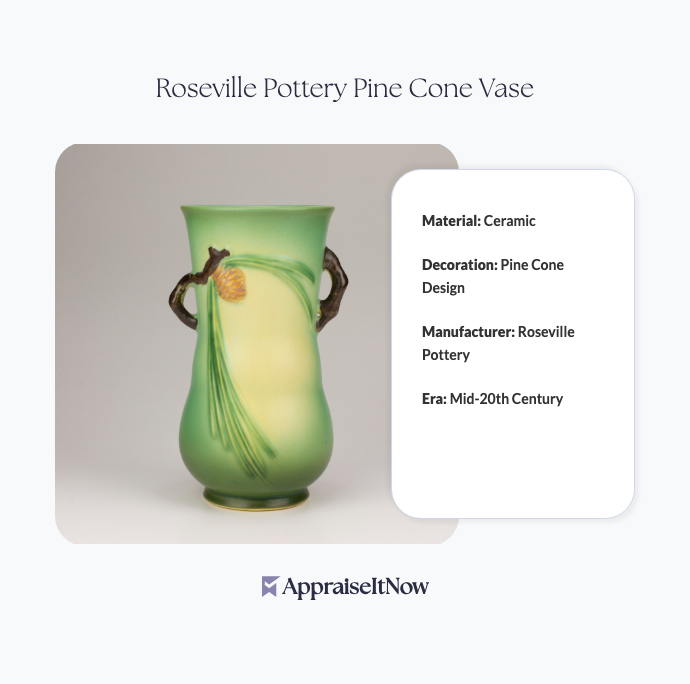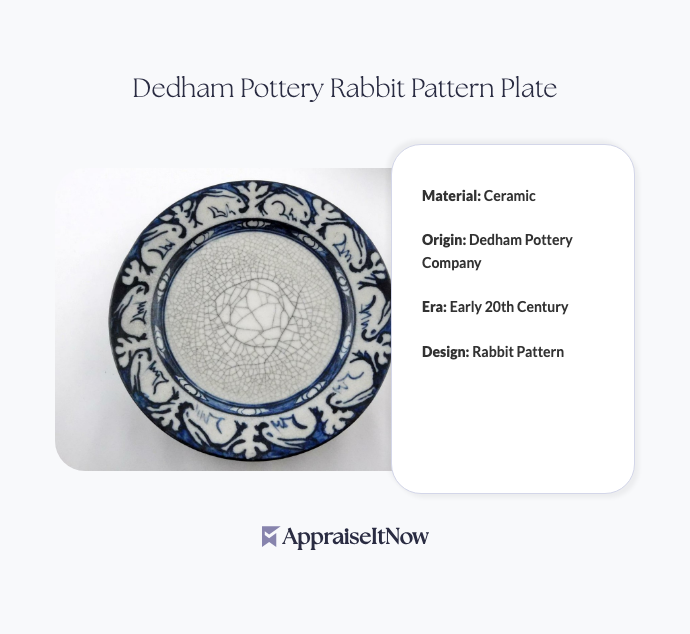<h1>How to Get Your Paul Revere Pottery Appraised</h1>
<p>Paul Revere Pottery stands as one of America's most treasured ceramic collections, commanding estimated values between <strong>$1,800 and $2,500</strong> depending on condition, age, and provenance. If you own a piece from this historic pottery line and want to understand its true market value—whether you're considering selling, insuring, or simply verifying what you have—a professional appraisal is essential.</p>
<h2>Understanding Paul Revere Pottery Value</h2>
<p>Your Paul Revere Pottery piece represents more than decorative tableware. Founded in <strong>1908</strong>, this American ceramic brand pioneered Arts and Crafts design philosophy through intricate patterns and hand-applied glazes that set it apart from mass-produced competitors. The collection's enduring value stems from three core factors: historical significance as a cornerstone of the American ceramic arts movement, artisanal quality achieved through traditional hand-crafted techniques, and the brand's limited production runs that created natural scarcity in today's marketplace.</p>
<p>When collectors ask "<em>What is the most sought after vintage pottery?</em>" the answer frequently includes Paul Revere alongside other Arts and Crafts-era manufacturers. Your piece's specific worth depends heavily on which piece type you own—is it a dinner plate, teapot, vase, or decorative serving piece?—as well as its age, condition, and whether it retains maker's marks.</p>
<div class="callout tip"><p><strong>Valuation Driver</strong></p>
<p>Pieces signed by master potters command premium prices, often 15-25% above unsigned examples of similar age and condition.</p></div>
<h2>Why Professional Appraisal Matters</h2>
<p>Getting pottery appraised through professional services isn't simply a formality—it's a critical step that protects your investment and establishes documentation you'll need for multiple purposes. When you attempt informal valuation through general antiques websites or casual dealer estimates, you risk significantly undervaluing a legitimate collectible, particularly if the piece carries rare characteristics or exceptional condition.</p>
<p>A certified appraisal through services like <strong>AppraiseItNow</strong> provides <strong>USPAP-compliant documentation</strong> that insurance companies recognize, legal professionals accept, and buyers respect. This professional standard matters whether you're filing an insurance claim, planning an estate, negotiating a sale, or simply satisfying personal curiosity about your collection's worth.</p>
<p>Your appraiser will examine factors that casual observers might miss entirely—maker's marks positioning and style, glaze chemistry characteristics, production-era specific details, and historical documentation that establishes provenance. The question "<em>How do I find out how much my pottery is worth?</em>" finds its answer through this systematic expert evaluation rather than guesswork.</p>
<h2>Key Factors That Determine Your Piece's Value</h2>
<h3>Age and Production Era</h3>
<p>Paul Revere Pottery's production timeline matters significantly to valuation. Pieces from the brand's founding years (<strong>1908-1920s</strong>) typically command higher values than later examples, though exceptional designs from any era can achieve strong pricing. Your piece's manufacturing date influences not only desirability but also the specific characteristics appraisers examine—early production runs used different clay compositions and glaze formulations than later years.</p>
<p>Pieces bearing evidence of specific maker signatures become particularly valuable. Paul Revere employed master potters known for distinctive artistic contributions, and pieces signed by these artisans represent collectible items within the broader Paul Revere category. When seeking how much your specific piece is worth, documenting these signatures becomes your first investigation step.</p>
<h3>Condition and Preservation</h3>
<p>The condition spectrum dramatically affects pricing. A Paul Revere piece in excellent condition with no chips, cracks, or repairs might command the full <strong>$2,500</strong> estimate, while similar pieces showing wear, restoration, or damage might settle toward the <strong>$1,800</strong> lower bound. Appraisers examine glaze integrity, clay body condition, color vibrancy, and whether any prior repairs or replacements have been performed.</p>
<p>The phrase "Is pottery worth money?" finds nuanced answers through condition assessment. Even damaged or heavily used pieces retain value if they represent rare designs or exceptional maker marks, though restoration history substantially affects pricing. Professional appraisers document condition through detailed photography and written descriptions, providing transparent valuation foundations.</p>
<h3>Design and Rarity</h3>
<p>Not all Paul Revere pieces carry equal value. Distinctive Arts and Crafts designs with complex patterns, unusual color combinations, or experimental glazes typically command premiums over simpler service pieces. Limited production runs for specific designs create scarcity that drives collector interest and prices upward.</p>
<p>When wondering "<em>How to tell if a tea set is worth money?</em>", design distinctiveness becomes one primary indicator alongside maker marks and production era. Paul Revere's commitment to hand-crafted artistry meant variations between pieces—no two examples are perfectly identical—making certain configurations particularly rare and valuable. Your appraiser identifies these distinguishing characteristics and contextualizes them within market comparable sales data.</p>
<div class="callout note"><p><strong>Design Insight</strong></p>
<p>Experimental or unique glaze colors from early production years often exceed $2,500 in fair market value, particularly if accompanied by maker signatures and documented provenance.</p></div>
<h2>The Paul Revere Pottery Appraisal Process</h2>
<h3>What Professional Appraisers Examine</h3>
<p>A certified appraiser evaluating your Paul Revere pottery follows systematic procedures that go far beyond surface-level assessment. Your expert will photograph the piece from multiple angles, documenting any maker marks, signatures, or identifying characteristics under appropriate lighting. They'll examine the clay body density, glaze application technique, color consistency, and any evidence of repairs or alterations using specialized equipment when necessary.</p>
<p>The appraisal process includes research into recent comparable sales within the Paul Revere pottery market, ensuring valuations reflect current collector demand rather than historical pricing. Your appraiser accesses auction house results, dealer records, and collector forums to establish data-driven market positioning for your specific piece type and condition.</p>
<p>Appraisers qualified to assess <a href="/types/antique-artwork">antique artwork</a> and <a href="/types/memorabilia-and-collectibles">memorabilia and collectibles</a> bring specialized knowledge of Arts and Crafts movement history, American ceramic manufacturing techniques, and authentication standards that distinguish genuine Paul Revere pieces from reproductions or competing brands.</p>
<h3>How to Prepare for Your Appraisal</h3>
<p>Before scheduling your appraisal, gather any documentation related to your Paul Revere pottery piece. Provenance records—purchase receipts, family histories, auction catalogs—significantly enhance appraisal credibility and potentially increase valuations. Photograph your piece yourself, capturing any visible signatures, markings, or distinctive design elements. Document the piece's dimensions and note any visible wear patterns or repairs you've already identified.</p>
<p>Research contemporary comparable sales using online auction results and dealer listings. While these informal searches shouldn't be your sole valuation source, they establish baseline understanding of market ranges and familiarize you with terminology your appraiser will use. This preparation helps you ask informed questions during the appraisal consultation.</p>
<p>Ensure your piece is clean but not recently washed or handled excessively before appraisal—original patina and wear patterns communicate authenticity and historical accuracy that heavy cleaning might compromise. Store your piece safely in a dust-free environment until your appraisal appointment.</p>
<h2>Using Your Appraisal for Insurance and Documentation</h2>
<p>Once you've obtained professional appraisal documentation, use it strategically across multiple purposes. Insurance companies require certified appraisals for valuable personal property coverage, particularly for collections with items exceeding $500 in individual value. Submit your Paul Revere appraisal to your homeowner's or collector's insurance provider to ensure coverage reflects replacement cost rather than underestimated values.</p>
<p>For estate planning purposes, certified appraisals establish documented values that executors and beneficiaries can reference, reducing disputes and complications during inheritance processing. Tax professionals need accurate valuations when handling charitable donation deductions—our guide on <a href="/blog/personal-property-appraisals-for-charitable-donations-maximizing-tax-benefits-through-accurate-valuations">personal property appraisals for charitable donations</a> explains how appraisal documentation maximizes tax benefits.</p>
<p>When considering a future sale, professionally documented appraisals establish asking prices with credibility and provide potential buyers confidence in your valuation claims. Dealers and auction houses respect certified appraisals from recognized services when evaluating collection acquisitions.</p>
<h2>Where to Get Your Paul Revere Pottery Appraised</h2>
<p>Professional appraisal services specializing in ceramics and <a href="/types/household-goods">household goods</a> provide the expertise necessary for accurate Paul Revere valuation. <strong>AppraiseItNow</strong> connects you with credentialed appraisers holding certifications from recognized organizations including <strong>AAA, ISA, ASA, CAGA, and AMEA</strong>. Our secure online platform allows you to submit photographs and descriptions from home, receiving certified appraisals without requiring in-person appointments.</p>
<p>Look for appraisers with specific experience in Arts and Crafts pottery, American ceramics, or <a href="/types/antique-furniture">antique furniture and decorative arts</a>. Verify that your appraiser maintains current professional credentials and carries appropriate liability insurance. Personal recommendations from fellow collectors, museum curators, or antiques dealers can identify specialists with particular expertise in Paul Revere pottery valuation.</p>
<p>Understanding how to choose a qualified personal property appraiser ensures you receive fair market valuations from credentialed professionals who follow established valuation standards. The question "<em>How to get pottery appraised?</em>" finds its answer through connecting with services that combine subject matter expertise with formal appraisal methodology.</p>
<h2>Beyond Paul Revere: Valuing Your Broader Collection</h2>
<p>If you own multiple pottery pieces, appraisers can evaluate your entire collection systematically, providing individual valuations and overall collection assessments. When assessing broader <a href="/types/personal-property">personal property</a> collections, professional appraisers help identify your collection's most valuable components, guide preservation strategies, and recommend insurance coverage levels appropriate to overall asset value.</p>
<p>The insights our experts provide on <a href="/blog/appraising-fine-porcelain-and-ceramics-valuing-delicate-artistry">appraising fine porcelain and ceramics</a> apply broadly to ceramic collections beyond Paul Revere, helping you understand how production methods, historical era, maker reputation, and condition interact to create market value across diverse pottery forms.</p>
<div class="callout note"><p><strong>Key Takeaway</strong></p>
<p>Professional appraisal transforms uncertainty about your Paul Revere Pottery's worth into documented, credible valuation you can use with confidence for insurance, sale, or estate planning purposes. By connecting with certified appraisers through platforms like AppraiseItNow, you ensure your ceramics receive expert evaluation based on current market data and established appraisal standards, protecting your investment and providing peace of mind about your collection's true value.</p></div>







.avif)







